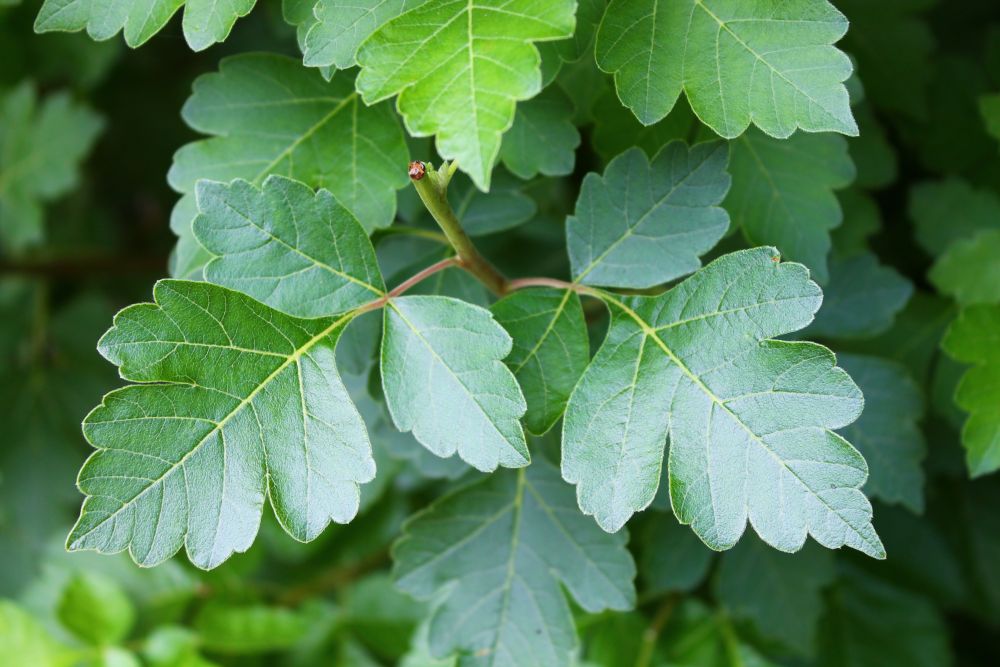
Hoary vervain.
Still with half its blooms, the hoary vervain (Verbena stricta) welcomed us with a hardy greeting on a very cold, rainy October morning. Those hardy blossoms reminded us of the warmer days of summer.
Ivan (a Garden Steward volunteer), Erin (LEAF’s Volunteer Stewardship Co-ordinator) and I met at the Spadina Urban Forest Demonstration Garden to chat about how the garden had fared during the summer and to start planning for the fall clean-up.
The Spadina garden is located at the Walmer entrance just north of Bloor. It’s a busy, busy intersection of commuters heading to the subway and parents shepherding their children to the neighbourhood school. It’s also a transportation corridor, as massive numbers of bikes, buses, and cars pass the garden every day.

Hackberry tree.
Beyond regular traffic, there are trucks with daily deliveries, repairs and servicing. The day we visited the garden, a large refrigeration truck (engine on) was camped beside the hackberry tree (Celtis occidentalis) running electrical cords and hoses inching in the edge of the garden.
All that daily commotion and stress makes it even more difficult for the Spadina gardeners. However, during spring planting they chose hardy plants with lots of feistiness to survive the tough urban landscape - like the hoary vervain who greeted us.
Though early fall, it was still easy to see the beauty of this garden space.

The honey locust tree (left) and hackberry trees (right) anchor the garden.
Anchoring the garden are the hackberry tree to the south and the honey locust (Gleditsia triacanthos) planted right in the centre. Planted in 2010, and rooted for six years, they remain tall and healthy -- ready to tackle the winter.

Fragrant sumac.
The fragrant sumac (Rhus aromatica) anchors the north end of the garden was still very vibrant with many summer berries on its branches.
As we munched on hackberries commenting on the taste and texture, Ivan shared the garden’s summer stories.
All Toronto gardens suffered this summer from the ever dry conditions. However, at the Spadina location, it was complicated by that fact that the water source was restricted due to building renovations and kept the stewards on their toes to ensure that the plants didn’t dry to a crisp.
Between the heat, the lack of water and an on-going battle with aphids, it was impressive to see how well all the plants had done, particularly the red osier dogwood (Cornus sericea) which seemed ever more deeply entrenched in the garden.
We mused on that adding a few more perennials might be a good idea for next year – giving the area a little more colour.

LEAF’s Urban Forest Demonstration Garden at the Spadina TTC Station.
Just as we were packing up, a young child walking with her mother ignored the sidewalk in favour of the stepping stones on the perimeter of the garden, counting them off one-by-one. She paused to enjoy the blossoms on the hoary vervain.
That image of the youngster enjoying the last flowers of the season resonated strongly with me. I think it’s a reflection of the important work of the urban demonstration gardens and the relevance and enjoyment they bring to Torontonians.
______________________
Heather Robertson lives near Wychwood Barns with her partner Nick and their dog Cruiser. They are great supporters of the urban environment experience, admiring their neighbour’s wild gardens and fostering the tree in their front garden.
Photographs by Heather Robertson, Kanchan Maharaj, and Brenna Anstett.
LEAF’s Urban Forest Demonstration Gardens are supported Ontario Power Generation’s Biodiversity Program and the Toronto Transit Commission.
